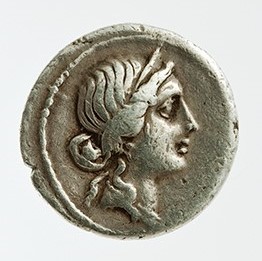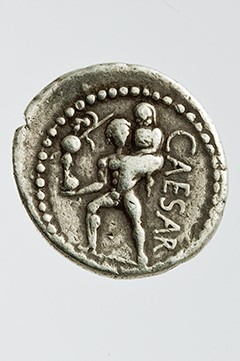Acquisition number: 1974.06
Obv.: Head of Venus r., diademed, wearing necklace; hair in knot, falling in two locks. Border of dots.
Rev.: Aeneas fleeing l., holding palladium in right hand carrying Anchises on his left shoulder. (Palladium = statue of Minerva, left, wearing plumed helmet and carrying small round shield and long spear.) On right, CAESAR (downwards). Border of dots.
Title: Denarius of Julius Caesar - 1974.06
Acquisition number: 1974.06
Author or editor: Beryl Rawson
Culture or period: Roman Republic
Date: 47-46 BC
Material: Metal - Silver
Object type: Coins - Roman
Dimensions: 18mm (w)
Origin region or location: Italy
Origin city: Rome
Display case or on loan: 5
Keywords: Coin, denarius, Roman, Republic, Venus, Aeneas, Julius Caesar
Sear, D.R., Roman Coins and their Values 5 vols (London, Spink, 2000-2014) 1402; Crawford, M., Roman Republican Coinage 2 vols (Cambridge, Cambridge University Press, 2011) 458/1 and pl. LIV.10; Sear, D.R., The History and Coinage of the Roman Imperators (London, Spink, 1998) 55; Grueber, H.A., Coins of the Roman Republic in the British Museum 3 vols (London, The Trustees of the British Museum, 1910; rev. edn London, 1970) East 31; Seaby, H.A., Roman Silver Coins (London, B.A. Seaby, 1967) 12(North Africa 47-46 BC); Sydenham, E. A. The Coinage of the Roman Republic (London, Spink, 1952; (Sanford J. Durst repr. 1976) 1013.
Valverde, L. Amela, ‘La serie RRC 458 de César’, Revista Hécate, 5 (2018), 10-16. Kluczek, A.A., ‘Faces of Aeneas. Representations on Roman coins and medallions’, Studia Ceranea 6 (2016), 295-321. Scherer, M., The Legends of Troy in Art and Literature, 2nd edn. (New York, Phaidon, 1964).
1974.06
Denarius of Julius Caesar
3.666 g. 47-46 BC
Obv.: Head of Venus r., diademed, wearing necklace; hair in knot, falling in two locks. Border of dots.
Rev.: Aeneas fleeing l., holding palladium in right hand carrying Anchises on his left shoulder. (Palladium = statue of Minerva, left, wearing plumed helmet and carrying small round shield and long spear.) On right, CAESAR (downwards). Border of dots.
This issue was struck in large numbers and is considered to represent Caesar’s war coinage for the campaign in Africa against the Pompeians. It was struck by a military mint travelling with Caesar in Africa. The theme of the ancestry of Caesar is reinforced here with the representation of Aeneas’ rescue of his father and of sacred objects from Troy. [David R Sear, The History and Coinage of the Roman Imperators 49–27 BC, Spink, 1998, p.38.]
The date is presumably between 48 and 46 BC. In 48 BC Caesar defeated Pompey at Pharsalus. Caesar had used ‘Venus Victrix’ (Venus the victory-bringer) as his watchword on the day of the battle and had vowed her a temple (Appian Civil Wars 2.68). By 46 BC he had dedicated a temple to Venus Genetrix (Venus the Procreator) in his new forum. As he was in the East between 48 and September 47 BC, any initiatives for new coinage probably did not come until he returned to Italy. Hoard evidence suggests a date of 47-46 BC and Crawford (93) thus associates the issue with Caesar’s African campaign.
Venus had been associated with Rome’s state religion since at least the third century BC. As Venus Genetrix she came to be thought of as the mother of the Roman people. In the Aeneas legend she was also the mother of Aeneas (whose father was Anchises), and the Julian family claimed descent from her through Aeneas’ son Iulus (Ascanius) (cf. Vergil Aeneid 1.288 and Ovid Metamorphoses 14.583). Some Iulii had been putting a figure of Venus on their coins since 129 BC, and some other families (e.g. the Memmii) also chose the Venus type. The first known head of Venus on a Roman coin belongs to 83 BC Julius Caesar, who had advertised his family’s descent from Venus as early as 69 BC (Suetonius Iulius 6), developed his family’s connection with the Trojan legend by associating Venus with the Aeneas-Anchises type on his coins of the forties.
The story of Aeneas’ from Troy was already known and represented in art in Etruria by the end of the 6th century BC. It was probably from Etruria that the story first reached Rome. The oldest certain Roman representation of the story is on coins of Julius Caesar such as the present one. Soon after, Dionysius of Halicarnassus (1.69.2 ff, 2.66) recorded the story of Aeneas’ rescue from Troy of the palladium and other sacred things which were later safeguarded by the Vestal Virgins in the temple of Vesta at Rome. The palladium was a statue of Pallas (= Roman Minerva) which guaranteed the safety of Troy, and later that of Rome when it was brought there. (There was some dispute as to whether the Greeks had stolen the original palladium from Troy or only a replica.)
Under Augustus the definitive Roman version of the legend developed, and the sculptured group representing Aeneas, Anchises on Aeneas’ left shoulder, and Ascanius being led by Aeneas’ right hand, was set up in Augustus’ new forum. That is the scene described by Vergil Aeneid 2.706 ff and Ovid Fasti 5.563 ff. The emphasis on Aeneas’ pietas, symbolised by his rescue of father, son and sacred objects, continued in many artistic monuments of the first two centuries AD. ‘The emperors were most eager to propagate this notion [of Aeneas pius the founder of Rome]. As is so often the case, this propagandist intent is most conspicuous of the coin issues.’ (Galinsky 4) Trajan, however, a man of military reputation and interests, early in the second century AD reissued Caesar’s coin, which showed Aeneas as a more martial figure than did other representations. (See Galinsky fig. 3 for Trajan’s coin.)
The following account of the development of the Aeneas-Anchises theme under Augustus and later is based on Fuchs:
Octavian issued an early gold coin (between 42 and 38 BC) with his own head on the obverse and the Aeneas-Anchises pair on the reverse. But the reverse type is different from Julius Caesar’s: Aeneas carries Anchises aloft, more like the figures of Anapias and Amphinomos (the dutiful brothers of Catana, Sicily) rescuing their parents from the eruption of Mt. Etna, who had been represented on a PIETAS coin minted in Rome c. 108 BC (by M. Herennius). (Cf. the representation of this legend on Sextus Pompeius’ coin from Sicily of about the same time as Octavian’s: 72.02). Perhaps the political climate soon after the death of Caesar prevented Octavian’s using the Etruscan type of the Aeneas-Anchises legend which had been used by Caesar. Some reminiscences of Caesar could be dangerous, especially direct association of Rome’s origins with the East. For his early coin Octavian chose a Sicilian model; by the time of his new forum and Vergil’s Aeneid the legend had been transformed into the ‘definitive’ version (see above). ‘The flight of Aeneas from Troy forms the beginning of the legend which deeply underpins the world leadership of Rome: tantae molis erat Romanum condere gentem.’ (‘Such was the cost in heavy toil of beginning the life of Rome,’ Aeneid 1.33, trans. W.F. Jackson Knight.)
The centrepiece of Augustus’ forum, the temple of Mars Ultor, was vowed in 42 BC. The temple and the forum were dedicated in 2 BC. The Aeneas group was probably one of the earlier pieces of sculpture finished: 27-22 BC? (Vergil had begun the Aeneid c. 29 BC, and read part of it to Augustus in 23 BC.) (On the position and significance of this group in the northern hemicycle of Augustus’ forum, see MacKendrick pp. 146-7.) We have to reconstruct the sculpture from later copies (of which there were many). Aeneas was fully clothed, in contrast with the ‘Greek heroic’ nudity of Caesar’s coin type. The frontality of the treatment of the group reinforced its impact as a symbol of pietas (dutiful respect).
For comparisons with Aeneas on the Ara Pacis, see Galinsky 10 and ch. 5 (191-241) and Scherer 181-216.
Sear, D.R., Roman Coins and their Values 5 vols (London, Spink, 2000-2014) 1402; Crawford, M., Roman Republican Coinage 2 vols (Cambridge, Cambridge University Press, 2011) 458/1 and pl. LIV.10; Sear, D.R., The History and Coinage of the Roman Imperators (London, Spink, 1998) 55; Grueber, H.A., Coins of the Roman Republic in the British Museum 3 vols (London, The Trustees of the British Museum, 1910; rev. edn London, 1970) East 31; Seaby, H.A., Roman Silver Coins (London, B.A. Seaby, 1967) 12(North Africa 47-46 BC); Sydenham, E. A. The Coinage of the Roman Republic (London, Spink, 1952; (Sanford J. Durst repr. 1976) 1013.
Valverde, L. Amela, ‘La serie RRC 458 de César’, Revista Hécate, 5 (2018), 10-16. Kluczek, A.A., ‘Faces of Aeneas. Representations on Roman coins and medallions’, Studia Ceranea 6 (2016), 295-321. Scherer, M., The Legends of Troy in Art and Literature, 2nd edn. (New York, Phaidon, 1964).

